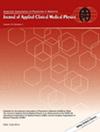High-precision localization of radiation isocenter using Winston-Lutz test: Impact of collimator angle, phantom position, and field size
Abstract
Purpose
This study aimed to evaluate the impact of collimator angle, ball bearing (BB) phantom position, and field size on the accuracy of Winston-Lutz (WL) test–derived radiation isocenters.
Methods
WL tests were performed on four TrueBeam linear accelerators. Fifty-six images (eight gantry angles multiplied by seven collimator angles) were acquired for each WL test. Images with different sets of collimator angles were used to compute the radiation isocenters. The resulting radiation isocenters were correlated with the collimator angles. Then, the BB position and radiation field size were varied for the subsequent WL tests. The calculated BB shifts were compared with the known shifts, and the radiation isocenters were compared between different field sizes.
Results
The use of a single collimator angle led to errors of as much as 0.4 mm in the calculated radiation isocenters. Systematic differences were observed between the radiation isocenters derived with collimator angle 0° and those derived with 90° and/or 270°. A commonly used opposing collimator angle pair, 90° and 270°, resulted in a vertical 0.1 mm offset of the radiation isocenters toward the ceiling. Oblique opposite or mixed collimator angles yielded radiation isocenter errors less than 0.1 mm. The BB shifts derived from WL tests were less than 0.1 mm from the known shifts. The radiation isocenters varied by less than 0.1 mm between field sizes ranging from 2 × 2 cm2 to 20 × 20 cm2.
Conclusions
Oblique opposing collimator angle pairs should be considered to minimize errors in localizing radiation isocenters. Uncertainty in BB positioning could be eliminated if the BB is used as a static reference point in space. The field size had no significant effect on the radiation isocenters. With careful design of WL test parameters and image processing, it is possible to achieve a precision of 0.1 mm in localizing radiation isocenters using WL tests.


 求助内容:
求助内容: 应助结果提醒方式:
应助结果提醒方式:


